
Athens, the historic heart and capital of Greece, is a captivating city where timeless ancient wonders blend seamlessly with the vibrant energy of modern urban life. Famous worldwide for iconic landmarks like the Acropolis, Parthenon, and the Ancient Agora, Athens offers a rich tapestry of history that transports visitors back to the cradle of Western civilization. Yet, beyond its archaeological treasures, the city pulses with lively neighborhoods filled with bustling markets, trendy cafes, and welcoming locals who embody Greece’s warm hospitality.
Whether you’re wandering through Plaka’s charming narrow streets, savoring authentic Greek cuisine in a traditional taverna, or exploring contemporary art galleries, Athens perfectly balances its storied past with dynamic present-day culture. The city’s Mediterranean climate and lively festivals add to its irresistible charm, making any time of year a great opportunity to visit. To help you make the most of your trip, here are the 10 best places to visit in Athens and tips on the ideal seasons to experience this unforgettable destination.
Top 10 Best Places to Visit in Athens
The Acropolis & Parthenon

Photo by Zois Fotis on Pexels
Rising majestically above the city of Athens, the Acropolis is one of the world’s most famous ancient archaeological sites, embodying the spirit and history of Classical Greece. At its heart stands the Parthenon, a stunning temple dedicated to the goddess Athena, offering visitors an unforgettable journey through history, art, and architecture.
🌟 Highlights of The Acropolis & Parthenon
🏛️ The Parthenon:
This iconic temple, built in the 5th century BC, is a masterpiece of Doric architecture, celebrated for its perfect proportions and intricate sculptures depicting Greek mythology and civic pride.
🌄 Panoramic Views:
The Acropolis hill provides breathtaking views of Athens and the surrounding landscape, making it a fantastic spot for photography and soaking in the city’s ancient and modern blend.
🕌 Other Historic Monuments:
Explore nearby landmarks within the Acropolis complex, such as the Erechtheion with its famous Caryatid statues, the Temple of Athena Nike, and the Propylaea entrance gate.
🏺 Acropolis Museum:
Just a short walk away, this modern museum houses priceless artifacts and sculptures found on the site, enhancing your understanding of the Acropolis’s rich history.
🚗 How to Get There
- By Public Transport:
Take the Athens Metro to Acropoli Station (Line 2), which is just a short walk from the entrance. - On Foot:
The Acropolis is centrally located and easily accessible on foot from neighborhoods like Plaka and Monastiraki.
🕒 Visitor Information
- Opening Hours:
Typically open daily from 8:00 AM to 7:00 PM (hours may vary seasonally). - Entry Fee:
Tickets cost around €20 in peak season, with reduced rates and free entry days for EU citizens under 25 and certain holidays. - Recommended Visit Duration:
Spend 2 to 3 hours exploring the site and nearby museum.
💡 Travel Tips
- 👟 Wear Comfortable Shoes:
The rocky terrain and uphill climb require sturdy, comfortable footwear. - ☀️ Best Time to Visit:
Early morning or late afternoon visits avoid the midday heat and crowds. - 💧 Stay Hydrated:
Bring water, especially in summer when temperatures soar. - 🎧 Guided Tours or Audio Guides:
Enhance your experience with expert insights into the history and symbolism of the monuments.
The Acropolis & Parthenon stand as enduring symbols of ancient Greek civilization and democracy. Visiting this historic site offers a profound connection to the past and an inspiring view of Athens’s vibrant present—a must-see for history buffs and travelers alike.
Acropolis Museum
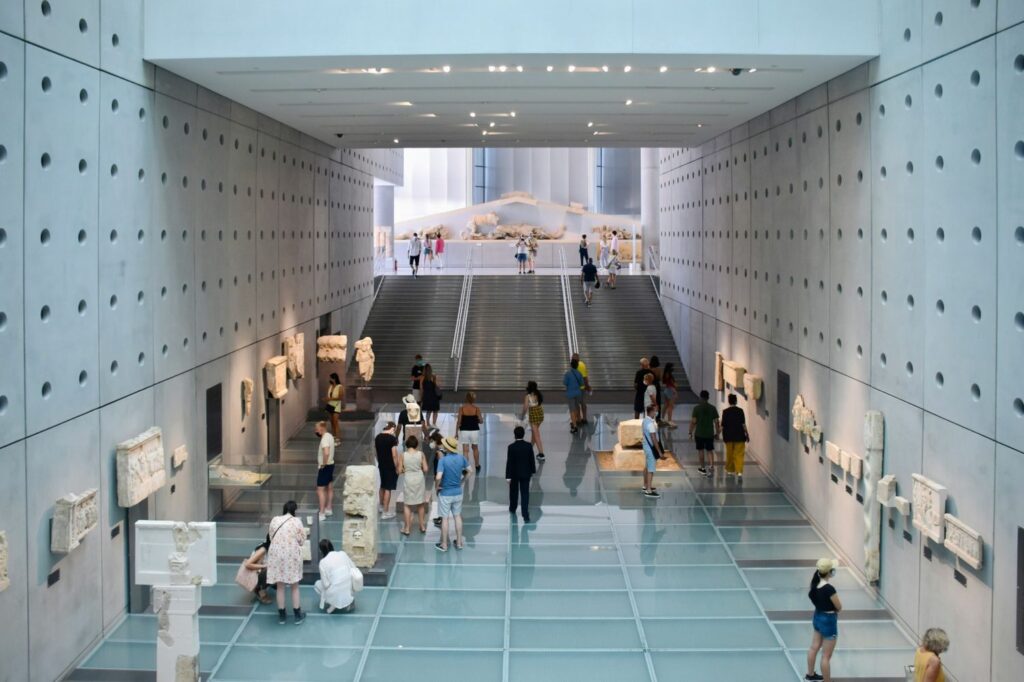
Photo by Arno Senoner on Unsplash
Located just a stone’s throw from the Acropolis hill, the Acropolis Museum in Athens is a stunning contemporary space dedicated to preserving and showcasing the treasures of the Acropolis. It offers visitors an immersive experience, connecting them directly to the art, culture, and history of ancient Greece.
🌟 Highlights of the Acropolis Museum
🏺 Extensive Artifact Collection:
The museum houses over 4,000 artifacts excavated from the Acropolis, including sculptures, pottery, jewelry, and architectural fragments dating from the Neolithic to Roman periods.
🏛️ Glass Floor Exhibits:
Walk above the original archaeological excavation site thanks to the museum’s innovative glass floor, which reveals the ruins beneath and provides context for the displayed artifacts.
🎨 The Parthenon Gallery:
This top-floor gallery features the famous friezes and metopes from the Parthenon, displayed with natural lighting designed to mimic the original outdoor setting.
🔍 Interactive Displays:
Multimedia installations and detailed explanations help visitors understand the cultural and historical significance of each exhibit.
🚗 How to Get There
- On Foot:
Located at the southeastern foot of the Acropolis, it’s an easy walk from the historic neighborhoods of Plaka and Monastiraki.
🕒 Visitor Information
- Opening Hours:
Open daily except Tuesdays, from 8:00 AM to 8:00 PM (summer) and 8:00 AM to 5:00 PM (winter). - Entry Fee:
General admission is around €10, with discounts for students and free entry on certain days. - Recommended Visit Duration:
Spend 1.5 to 2 hours exploring the exhibits at a comfortable pace.
💡 Travel Tips
- 🎟️ Book Tickets in Advance:
Secure your timed entry online to avoid long queues, especially during peak tourist seasons. - 📱 Use the Museum App:
Download the official app for audio guides and detailed information on the collections. - 👟 Comfortable Footwear:
The museum is spacious and requires a good amount of walking. - 📸 Photography:
Allowed in most areas without flash — check for restrictions in special exhibits.
The Acropolis Museum beautifully bridges ancient and modern worlds, offering a rich narrative of Greek history through its thoughtfully curated artifacts and innovative design. It’s a must-visit for anyone wanting to deepen their appreciation of Athens’s legendary heritage.
Plaka Neighborhood
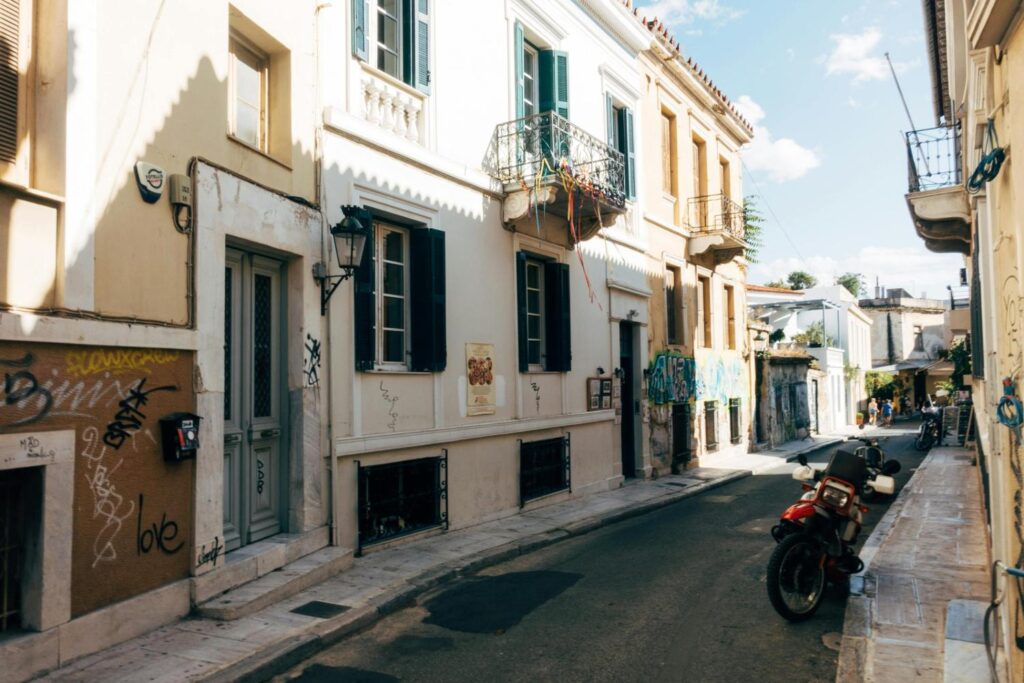
Photo by Markus Winkler on Pexels
Nestled under the shadow of the Acropolis, the Plaka Neighborhood is Athens’s oldest district and a vibrant tapestry of history, culture, and local life. Its narrow cobblestone streets, neoclassical architecture, and lively atmosphere make Plaka an essential stop for anyone wanting to experience the true spirit of Athens.
🌟 Highlights of Plaka Neighborhood
🏛️ Historic Streets & Architecture:
Wander through winding alleys lined with pastel-colored houses, ancient ruins, and Byzantine churches, offering a living museum of Athens’s layered past.
🍽️ Traditional Taverns & Cafés:
Enjoy authentic Greek cuisine at family-run tavernas, sip coffee in quaint cafés, and sample local sweets like baklava and loukoumades.
🛍️ Unique Shopping:
Discover artisanal shops selling handmade jewelry, leather goods, and souvenirs, perfect for finding one-of-a-kind gifts.
🎭 Cultural Vibe:
Frequent live music performances, street art, and festivals give Plaka a lively, bohemian flair that appeals to artists and travelers alike.
🖼️ Museums & Galleries:
Visit small museums like the Museum of Greek Folk Art or explore local art galleries showcasing contemporary Greek artists.
🚗 How to Get There
- By Public Transport:
The nearest Metro station is Monastiraki (Lines 1 and 3), located at the edge of Plaka. - On Foot:
Easily accessible by foot from the Acropolis, Syntagma Square, and Monastiraki areas.
🕒 Visitor Information
- Opening Hours:
The neighborhood is open 24/7, but shops and museums typically operate from 10:00 AM to 6:00 PM. - Entry Fee:
Free to explore; entry fees apply for museums and specific attractions. - Recommended Visit Duration:
Allocate 2 to 4 hours to fully enjoy wandering, dining, and shopping.
💡 Travel Tips
- 👟 Wear Comfortable Shoes:
The cobblestone streets can be uneven, so comfortable walking shoes are a must. - 📷 Explore Early or Late:
Visit early in the morning or later in the evening to avoid the busiest tourist crowds. - 🛍️ Bargain Politely:
Some shops may allow light bargaining, especially for souvenirs. - 🌟 Nearby Attractions:
Combine your visit with stops at the Acropolis, Roman Agora, and Monastiraki Flea Market.
The Plaka Neighborhood perfectly captures Athens’s timeless charm—a place where ancient history meets vibrant modern life. Whether you’re savoring traditional dishes, hunting for souvenirs, or simply soaking in the atmosphere, Plaka invites you to experience the heart and soul of Greece’s capital city.
Ancient Agora
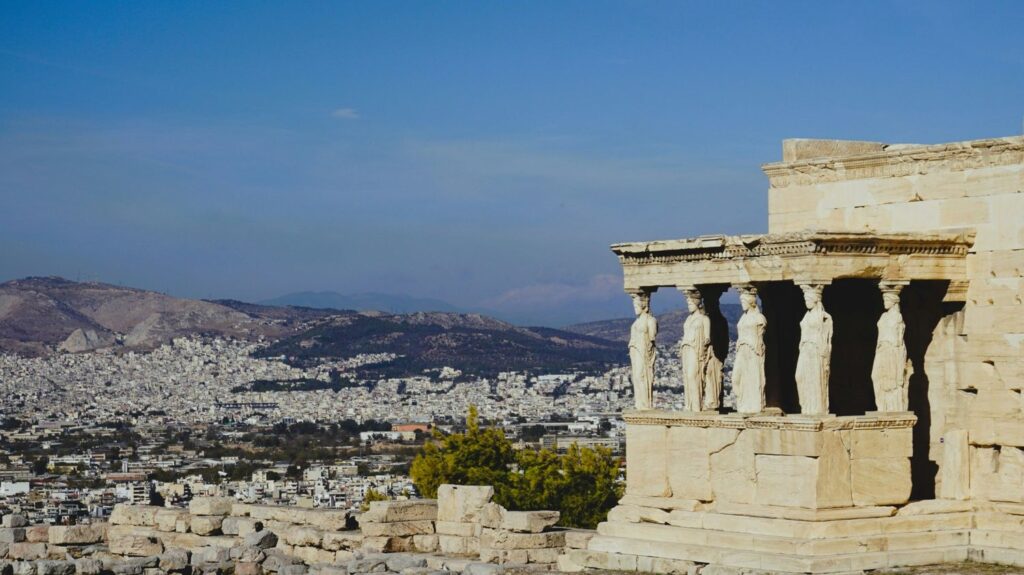
Photo by Kateryna Kovtun on Unsplash
Step back in time at the Ancient Agora of Athens, the vibrant marketplace and civic center that once formed the bustling heart of the city’s social, political, and commercial life. This sprawling archaeological site offers a fascinating glimpse into ancient Greek democracy and daily life.
🌟 Highlights of the Ancient Agora
🏛️ The Stoa of Attalos:
A beautifully reconstructed covered walkway housing the Agora Museum, where you can admire artifacts like pottery, sculptures, and coins unearthed from the site.
⚖️ The Bouleuterion:
Explore the ruins of the council house where the city’s governing body, the Boule, met to discuss public affairs.
🗽 Temple of Hephaestus:
One of the best-preserved ancient Greek temples, dedicated to the god of craftsmanship and metalworking, offering stunning views over the Agora.
📜 Archaeological Ruins:
Wander among temples, altars, statues, and public buildings that narrate the story of ancient Athenian society.
🌳 Scenic Surroundings:
The Agora is dotted with olive trees and gardens, making it a peaceful spot to explore on foot.
🚗 How to Get There
- By Public Transport:
The nearest Metro station is Monastiraki (Lines 1 and 3), just a short walk from the Agora entrance. - On Foot:
Easily accessible from the Acropolis, Plaka, and Monastiraki areas.
🕒 Visitor Information
- Opening Hours:
Open daily from 8:00 AM to 7:00 PM (hours vary seasonally). - Entry Fee:
Entry is approximately €8, with discounts for students and free admission on select days. - Recommended Visit Duration:
Spend around 1.5 to 2 hours exploring the ruins and museum.
💡 Travel Tips
- 👟 Wear Comfortable Shoes:
Uneven terrain and open-air walking require sturdy footwear. - ☀️ Visit Early:
Early morning visits help avoid crowds and the midday heat. - 📷 Bring a Camera:
The well-preserved ruins and scenic views offer fantastic photo opportunities. - 🎧 Guided Tours:
Consider a guided tour or audio guide to fully appreciate the history and significance of the site.
The Ancient Agora is more than just ruins—it’s a vivid window into the daily lives and democratic ideals of ancient Athenians. For history enthusiasts and curious travelers, it’s a must-see that enriches any visit to Athens.
Syntagma Square and the Changing of the Guard

Photo by Alexandro Pasqualicchio on Unsplash
At the center of Athens, Syntagma Square stands as a lively hub of political, social, and cultural life. Famous not only for its bustling atmosphere but also for the captivating Changing of the Guard ceremony, it’s a must-visit spot that offers both historical significance and an engaging spectacle.
🌟 Highlights of Syntagma Square & Changing of the Guard
🏛️ The Hellenic Parliament Building:
Overlooking the square, this grand 19th-century neoclassical building serves as Greece’s parliament and the backdrop for the iconic guard ceremony.
🪖 The Evzones Guard Ceremony:
Watch the traditional ceremonial changing of the guards, performed by the elite Evzones unit in their distinctive uniforms featuring the iconic pom-pom shoes and fustanella skirts. The ceremony is a precise and rhythmic performance full of history and symbolism.
⏰ Ceremony Times:
The Changing of the Guard takes place every hour on the hour, with a full ceremonial march every Sunday at 11:00 AM.
🌳 Beautiful Surroundings:
The square itself features fountains, gardens, and the Tomb of the Unknown Soldier, where the guards stand watch.
🛍️ Nearby Attractions:
Syntagma Square is a gateway to Athens’s shopping districts, cafes, and historic neighborhoods like Plaka.
🚗 How to Get There
- By Public Transport:
The square is served directly by Syntagma Metro Station (Lines 2 and 3), making it easy to access from anywhere in the city. - On Foot:
Centrally located, it’s a short walk from major sites such as the Acropolis and Monastiraki.
🕒 Visitor Information
- Changing of the Guard Schedule:
Hourly changes daily; full ceremonial march every Sunday at 11:00 AM. - Best Time to Visit:
Early morning or around Sunday 11:00 AM for the full ceremony experience. - Entry Fee:
Free to watch the ceremony and explore the square.
💡 Travel Tips
- 📷 Arrive Early:
Secure a good viewing spot for the Sunday full ceremony, as it attracts large crowds. - 👟 Comfortable Shoes:
You’ll likely be standing or walking around to catch the event and explore the area. - 🧢 Dress Appropriately:
Especially in summer, bring sun protection as much of the square is open and exposed. - 📚 Learn the History:
Reading up on the Evzones and Greek political history enhances the experience.
Syntagma Square is not just the political heart of Athens but a vibrant meeting place where history and modern life collide. The Changing of the Guard ceremony offers a fascinating glimpse into Greek tradition and pride—an unmissable spectacle for visitors exploring the city.
Mount Lycabettus

Photo by Klāvs Taimiņš on Unsplash
Rising 277 meters above the city, Mount Lycabettus is Athens’s highest hill and offers arguably the best panoramic views of the Greek capital. Whether you’re seeking a scenic sunset, a peaceful escape from the urban bustle, or a bit of adventure, this iconic hill is a must-visit destination.
🌟 Highlights of Mount Lycabettus
🌅 Breathtaking Views:
From the summit, you can enjoy sweeping 360-degree views of Athens, including the Acropolis, the Aegean Sea, and Mount Hymettus.
🚡 Funicular Railway:
A charming funicular takes visitors from the base to the top, making the ascent easy and scenic.
⛪ Chapel of St. George:
Visit this quaint whitewashed chapel perched at the peak, adding a cultural touch to your visit.
🍽️ Hilltop Café & Restaurant:
Relax with a coffee or a meal while soaking in the views at the café and restaurant located near the summit.
🌳 Hiking Trails:
For those who prefer an active approach, several walking paths lead to the top through pine forests and natural surroundings.
🚗 How to Get There
- By Public Transport:
Take the bus or metro to central Athens and then a short taxi or walk to the funicular station on Aristippou Street. - On Foot:
Hiking enthusiasts can climb from various starting points in Kolonaki or the city center.
🕒 Visitor Information
- Funicular Operating Hours:
Typically from 9:00 AM to 12:00 AM (hours may vary seasonally). - Entry Fee:
Funicular tickets cost around €7 for a round trip; hiking is free. - Recommended Visit Duration:
Allocate 1.5 to 2 hours to hike or ride up, explore, and enjoy the views.
💡 Travel Tips
- 📷 Best Time to Visit:
Sunset is magical, offering stunning views as the city lights up below. - 👟 Wear Comfortable Shoes:
Essential if you plan to hike the trails. - 🌟 Bring Water and Sun Protection:
The climb can be warm in summer months. - 🎵 Evening Events:
Check for occasional concerts held at the hilltop amphitheater.
Mount Lycabettus is a perfect blend of natural beauty, cultural charm, and breathtaking vistas, providing a memorable experience for every visitor to Athens. Whether you ascend by funicular or on foot, the view from the top is worth every step.
National Archaeological Museum
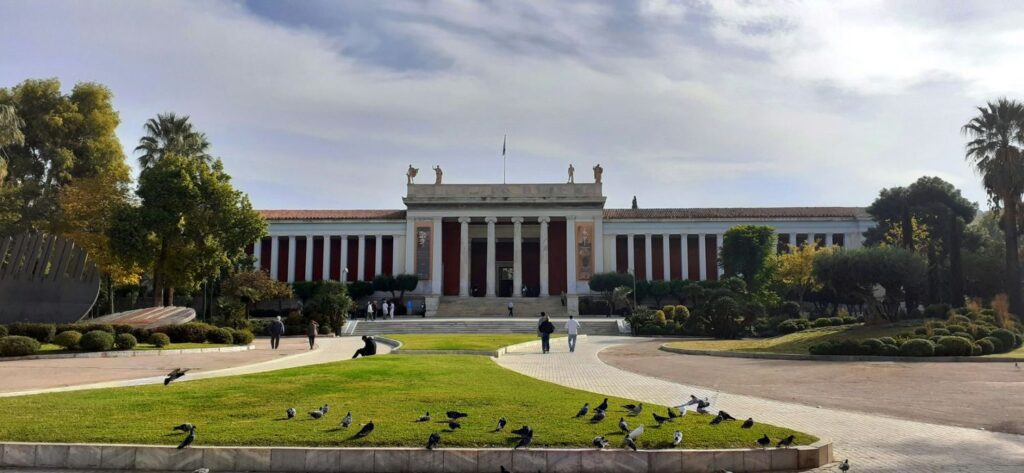
Photo by George Girnas on Unsplash
The National Archaeological Museum in Athens is one of the world’s greatest museums dedicated to ancient Greek art and history. Housing an extraordinary collection of artifacts spanning millennia, it offers visitors an unparalleled glimpse into the richness of Greece’s cultural heritage.
🌟 Highlights of the National Archaeological Museum
🏺 Vast Collections:
The museum showcases over 11,000 exhibits, including sculptures, pottery, jewelry, frescoes, and tools from prehistoric times to late antiquity.
🗿 Iconic Artifacts:
Marvel at masterpieces such as the Mask of Agamemnon, the Antikythera Mechanism, and the Statue of Poseidon, each telling stories from Greek mythology and history.
🏛️ Diverse Galleries:
Explore specialized sections like the Cycladic Art, Mycenaean Collection, Egyptian Collection, and Classical Sculpture galleries.
🔍 Educational Displays:
Informative panels and interactive exhibits help deepen your understanding of ancient Greek civilizations.
🚗 How to Get There
- By Public Transport:
Accessible via bus routes and a short taxi ride from central Athens; the nearest Metro station is Victoria (Line 1), about a 15-minute walk. - On Foot:
Located in the Exarcheia district, it’s a pleasant walk from Omonia Square or nearby neighborhoods.
🕒 Visitor Information
- Opening Hours:
Open daily except Tuesdays, from 8:00 AM to 8:00 PM (summer) and 8:00 AM to 5:00 PM (winter). - Entry Fee:
Tickets cost approximately €12, with reduced rates for students and free entry on certain days. - Recommended Visit Duration:
Spend at least 2 to 3 hours to explore the extensive collections comfortably.
💡 Travel Tips
- 🎟️ Buy Tickets Online:
Skip the lines by booking tickets in advance, especially during peak tourist seasons. - 📱 Use Audio Guides:
Rent an audio guide or download the museum’s app for detailed explanations of key exhibits. - 👟 Comfortable Footwear:
The museum is large, so prepare for extensive walking. - 📸 Photography Policy:
Photography without flash is generally allowed, but check restrictions for special exhibits.
The National Archaeological Museum is a must-visit for anyone passionate about ancient history and art. Its rich collections and immersive displays provide a fascinating journey through Greece’s storied past, making it one of Athens’s top cultural attractions.
Monastiraki Flea Market

Photo by Ricky Esquivel on Pexels
Located in the heart of Athens, the Monastiraki Flea Market is a lively and colorful marketplace that offers an eclectic mix of antiques, souvenirs, clothing, and street food. It’s the perfect place for curious travelers to dive into the city’s vibrant local culture and hunt for unique finds.
🌟 Highlights of Monastiraki Flea Market
🎁 Eclectic Shopping:
Browse countless stalls selling everything from vintage jewelry, handmade crafts, and leather goods to rare antiques and quirky souvenirs.
🍴 Delicious Street Food:
Sample authentic Greek treats like souvlaki, loukoumades (honey-soaked doughnuts), and freshly squeezed juices from lively food vendors.
🏺 Antique Shops:
Explore small shops specializing in ancient coins, pottery, and collectibles—a paradise for history buffs.
🎶 Vibrant Atmosphere:
Street musicians, lively chatter, and colorful displays create an energetic and welcoming environment.
🏛️ Proximity to Landmarks:
Located close to the Ancient Agora, Hadrian’s Library, and the Acropolis, making it easy to combine sightseeing with shopping.
🚗 How to Get There
- By Public Transport:
The market is easily accessible via Monastiraki Metro Station (Lines 1 and 3), right in the heart of the shopping district. - On Foot:
A short stroll from Plaka, Syntagma Square, and the Acropolis area.
🕒 Visitor Information
- Operating Hours:
Open daily from around 9:00 AM to 8:00 PM, with the busiest times on weekends. - Entry Fee:
Free to browse; prices vary depending on goods. - Recommended Visit Duration:
Allocate 2 to 3 hours for a relaxed shopping and exploration experience.
💡 Travel Tips
- 🛍️ Bargain Respectfully:
Haggling is common but always polite and good-natured. - 👟 Wear Comfortable Shoes:
The market streets are cobbled and can get crowded. - 💼 Watch Your Belongings:
Be mindful of your personal items, especially in busy areas. - 📅 Visit Early:
For the best selection and a less crowded experience, try to arrive in the morning.
The Monastiraki Flea Market is a lively snapshot of Athens’s local life and culture, perfect for treasure hunters, food lovers, and culture enthusiasts alike. Its dynamic blend of shopping, eating, and exploring makes it an unforgettable stop on any Athens itinerary.
Temple of Olympian Zeus
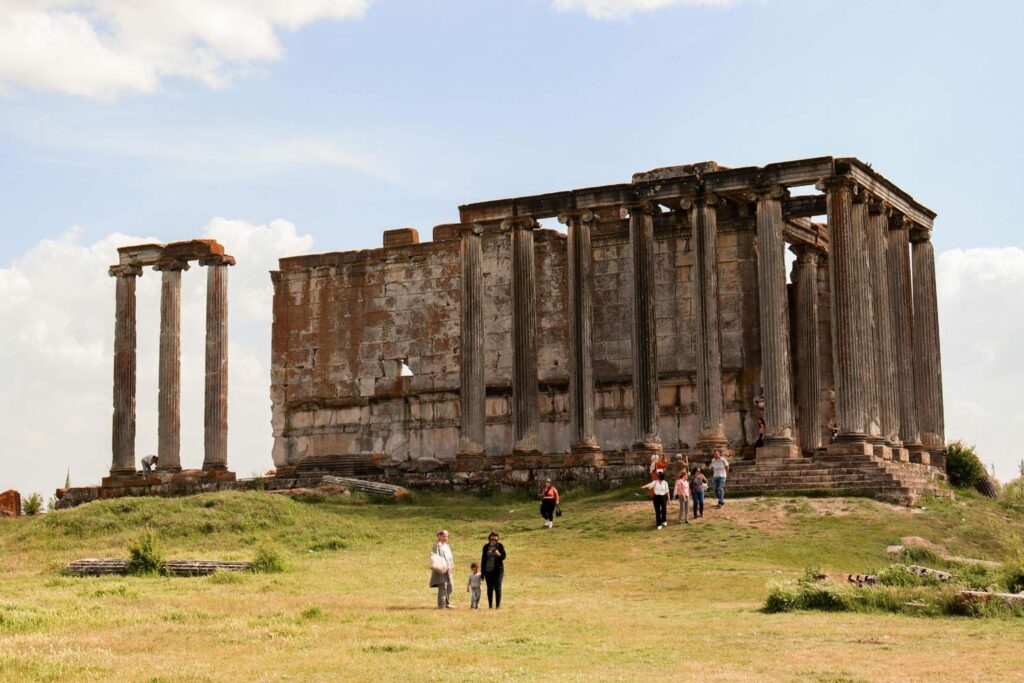
Photo by Zeynep Öngel on Pexels
The Temple of Olympian Zeus, also known as the Olympieion, stands as one of the most colossal and awe-inspiring ruins in Athens. Though only a fraction of the original temple remains today, its sheer scale and historical significance offer a powerful glimpse into ancient Greek architectural ambition and religious devotion.
🌟 Highlights of the Temple of Olympian Zeus
🗿 Massive Columns:
Marvel at the towering Corinthian columns—only 15 out of the original 104 remain—each soaring over 17 meters high, showcasing the temple’s monumental scale.
📜 Rich History:
Construction began in the 6th century BC and took nearly 700 years to complete, spanning several rulers and eras, including the Roman Emperor Hadrian who finally finished it.
🏛️ Architectural Wonder:
Once the largest temple in Greece, it was dedicated to Zeus, the king of the Olympian gods, reflecting the city’s religious and political power.
🌳 Scenic Surroundings:
Located near the National Garden and Zappeion Hall, the temple site offers a pleasant walking area with shaded paths and greenery.
📸 Photo Opportunities:
The temple’s majestic columns framed by the Acropolis skyline make for stunning photographs, especially during sunrise or sunset.
🚗 How to Get There
- By Public Transport:
Accessible via the Acropoli Metro Station (Line 2) or a short walk from Syntagma Metro Station. - On Foot:
A pleasant 10-minute walk from the Acropolis and Plaka neighborhoods.
🕒 Visitor Information
- Opening Hours:
Open daily from 8:00 AM to 7:00 PM (hours vary seasonally). - Entry Fee:
Entrance is often included with the Acropolis ticket (~€20) or can be purchased separately for around €6. - Recommended Visit Duration:
Spend about 30 to 45 minutes exploring the ruins and taking in the surroundings.
💡 Travel Tips
- 👟 Comfortable Footwear:
The site has uneven stone paths; sturdy shoes are recommended. - 📷 Best Time to Visit:
Early morning or late afternoon to avoid crowds and enjoy softer lighting for photos. - 🌞 Bring Sun Protection:
Limited shade is available, so carry water, a hat, and sunscreen. - 🧭 Combine with Nearby Sites:
Pair your visit with the Acropolis, Hadrian’s Arch, and the National Garden for a full day of historic exploration.
The Temple of Olympian Zeus is a testament to ancient Greek grandeur and endurance. Its impressive ruins continue to inspire awe and curiosity, making it a vital stop on any Athens sightseeing journey.
Gazi District

The Gazi District is one of Athens’s most vibrant and dynamic neighborhoods, renowned for its lively nightlife, eclectic dining scene, and thriving arts culture. Once an industrial area centered around the old gasworks (hence the name), Gazi has transformed into a hotspot where tradition meets modern urban flair.
🌟 Highlights of Gazi District
- 🍽️ Diverse Culinary Scene:
From trendy cafes and gourmet restaurants to casual street food joints, Gazi offers flavors to satisfy every palate. Try traditional Greek dishes, international cuisine, or creative fusion menus. - 🎶 Nightlife & Entertainment:
The district comes alive at night with bars, clubs, and live music venues playing everything from Greek folk to electronic beats, making it a favorite for locals and visitors alike. - 🎨 Art and Culture:
Explore contemporary art galleries, street art murals, and cultural spaces like Technopolis, a former gasworks turned arts and event center hosting exhibitions, concerts, and festivals. - 🛍️ Shopping:
Browse through boutique shops selling unique fashion, handmade jewelry, and local crafts. - 🌆 Urban Vibes:
The blend of old industrial architecture and modern street culture gives Gazi a unique, edgy atmosphere.
🚗 How to Get There
- By Public Transport:
Easily accessible via the Kerameikos Metro Station (Line 3), which places you right at the heart of Gazi. - On Foot:
A short walk from Monastiraki and Thissio neighborhoods.
🕒 Visitor Information
- Best Time to Visit:
Evening and night, when the district buzzes with activity and entertainment. - Entry Fee:
No entry fee; however, some clubs or events may charge cover charges. - Recommended Visit Duration:
Spend 2-4 hours to enjoy dining, bar hopping, and exploring cultural spots.
💡 Travel Tips
- 🍸 Plan Your Night Out:
Weekends are busiest, so consider arriving early or making reservations at popular venues. - 👟 Comfortable Shoes:
You’ll be walking a lot on cobbled streets and around crowded venues. - 🚕 Transport Back:
Keep taxis or ride-share apps handy for safe travel after late-night outings. - 📅 Check Event Schedules:
Technopolis hosts various events throughout the year—look up schedules to catch concerts or festivals.
The Gazi District perfectly captures modern Athens’s spirit — a place where culture, nightlife, and creativity collide. Whether you’re looking for a lively evening out or a cultural day visit, Gazi offers something exciting around every corner.
Best Time to Visit Athens
Spring (March to May)
Spring is arguably the best time to visit Athens. The weather is warm but not too hot, flowers bloom across the city, and tourist crowds are still manageable.
Summer (June to August)
Summer is peak season, with hot weather and busy tourist sites. It’s perfect if you want to combine city exploration with nearby beaches, but be prepared for crowds and higher prices.
Autumn (September to November)
Autumn offers cooler temperatures, fewer tourists, and beautiful fall colors. It’s an excellent time for sightseeing and enjoying outdoor cafés.
Winter (December to February)
Winter in Athens is mild compared to many European cities, with fewer tourists and lower prices. Some sites may have shorter hours, but it’s a peaceful time to explore.
Insider Tips for Visiting Athens
- Stay hydrated and use sunscreen, especially in summer.
- Wear comfortable shoes — Athens is best explored on foot, especially around archaeological sites.
- Book tickets online for popular attractions like the Acropolis to skip lines.
- Try local Greek cuisine — don’t miss out on dishes like moussaka, souvlaki, and baklava.
Final Thoughts
Athens beautifully balances its ancient heritage with lively modern culture, offering travelers a rich and rewarding experience. Whether you’re marveling at the Parthenon or enjoying a coffee in Plaka, Athens promises memories that will last a lifetime. Time your visit right, and get ready to walk through history!

I’m Shreyash Mhashilkar — a full-stack developer by profession, and a passionate explorer of the future at heart.
With a strong foundation in both front-end and back-end , I spend my days building websites and applications that are not just functional, but scalable, intuitive, and user-focused.






